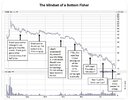- Joined
- 30 June 2007
- Posts
- 7,200
- Reactions
- 1,226
I have an AB question, since most of you guys use AB.
What's a good way to recreate the ASX price increments? I've been playing around with PREC() and ROUND() functions but can't quite get it.
Thanks.
What's a good way to recreate the ASX price increments? I've been playing around with PREC() and ROUND() functions but can't quite get it.
Thanks.
- <=.1 (3 decimal places)
- >.1 and <=2, .005 (3 decimal places, but rounded to .005)
- >2 (2 decimal places)

